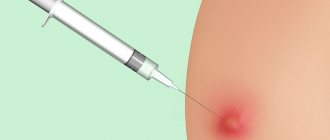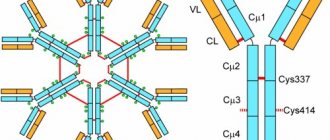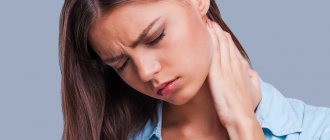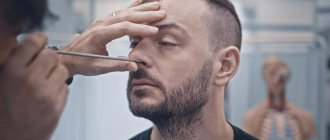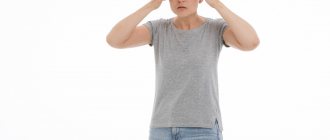Headache is one of the most common symptoms accompanying coronavirus infection. But even after recovery, it can be annoying for a long time, causing irritation, decreased performance and a general deterioration in the quality of life. Moreover, often a headache or cephalgia can be only one of the manifestations of the post-Covid syndrome, combined with other, no less unpleasant disorders: decreased or loss of smell, changes in taste, weakness, etc.
Features of manifestation
Cephalgia cannot be considered as a specific symptom specifically for infection with the SARS-CoV-2 coronavirus strain, since it can accompany many infectious and non-infectious diseases. Influenza, among other things, often occurs with headaches. And the frequency of their appearance does not always correlate with the severity and specificity of the pathological process.
Frequent attacks or even constant headaches are one of the most common complaints of people who have had coronavirus infection. At the same time, rarely does anyone notice exactly when it first appeared, since, as a rule, the headache begins to hurt in the first days of the disease, even before the appearance of the main symptoms, i.e. cough, fever, runny nose, weakness, etc. Therefore Cephalgia is often called a sentinel symptom of Covid. At the height of the illness, the pain can become simply excruciating, which is largely due to persistent fever. But the course of the disease without a significant increase in temperature does not guarantee the absence of cephalalgia. Usually it is closely associated with other disorders, in particular a decrease in the acuity of smell, taste disturbances, and disorders of the gastrointestinal tract.
With recovery, the headache does not always go away, and for many it persists for several weeks or even months afterward. This may be accompanied by a feeling of heaviness in the head, tingling in the limbs, persistence of impaired sense of smell and taste, and weakness.
There are still no reliable official statistics on the consequences of coronavirus. But according to some data already collected, headaches are observed in approximately 20% of people who required hospitalization. And WHO says that they are present in every 10th patient.
Headache after coronavirus can have varying intensity from mild to very strong and spread over the entire head like a “helmet”, or remain localized only in certain areas, for example, in the temples, back of the head, forehead, around the eyes, etc. By nature it can be one- or two-sided, squeezing, pulsating, dull and bursting, or even stabbing, and this largely depends on the causes of its occurrence. The data collected to date shows that after the coronavirus, there is an increase in previously noted headaches or a completely new manifestation.
An alarming symptom is the late appearance of headaches.
People's Councils
If there is pressure in the temples due to stress and nervous fatigue, an infusion with chamomile, which has a calming, antispasmodic, and analgesic effect, will help relieve the condition. The recipe for quick chamomile infusion is simple:
- Place 1 tsp in the teapot. dried chamomile flowers and pour 250 ml of boiling water.
- Cover the container with a lid and leave for 10 minutes.
- The finished product can be drunk with honey 2 – 3 times a day.
Some people find relief from headaches using compresses and lotions made from the following herbal ingredients:
- cabbage leaf;
- crushed leaves of peppermint, coltsfoot;
- chopped onion;
- lemon juice;
- ginger root, crushed to a paste;
- slices of unpeeled raw potatoes.
Spicy herbs help cope with migraines:
- basil;
- thyme;
- Melissa;
- marjoram;
- rosemary;
- fennel;
- lavender, etc.
If you have a headache in your temples due to high blood pressure, a warm foot bath with the addition of sea salt will help normalize the levels. You need to take a bath for 15–20 minutes, then put warm woolen socks on your feet and wrap yourself in a blanket. The procedure will help dilate blood vessels and normalize blood flow.
Why do you have a headache after coronavirus?
The possibility of penetration of the SARS-CoV-2 virus into the central nervous system (CNS) already has a lot of evidence. This is implemented in different ways. One of them is that viral particles overcome the blood-brain barrier, i.e., the physiological barrier between the bloodstream and the central nervous system, which means that the virus can enter the brain as a whole from any organ. It can also spread hematogenously, i.e. through the blood, as well as transneurally, i.e. through peripheral nerves.
Today there is a theory that the virus is able to invade the branch of the trigeminal nerve in the nasal or oral cavity. This largely explains the close connection between cephalalgia and disorders of smell and taste. Previous studies have proven the neurotropism of some strains of coronavirus, in particular the previously discovered SARS-CoV. It was found in brain cells but absent from cerebrospinal fluid. Therefore, it is very likely that the new strain of SARS-CoV-2 is also able to penetrate the nervous system through the cranial nerves and thereby provoke the development of cephalgia. This opinion has already been confirmed, and it has been noted that SARS-CoV-2 is more neurotropic than other viruses. Therefore, the presence of anosmia or taste disturbances is a signal of an increased risk of developing neurological complications.
During the pandemic, several cases of meningitis with COVID-19 have been reported, i.e. inflammation of the membranes of the brain as a result of damage by the virus. At the same time, patients in such situations were initially hospitalized in neurological departments with signs of meningitis and only later, during a PCR test, they were diagnosed with COVID-19.
Brain MRIs performed on patients after coronavirus often show the presence of microstrokes and leukoencephalopathy, i.e. damage to the white matter. This leads to pathological changes in the protective layer of brain cells (neurons) and a decrease in their number. The result is cognitive impairment of varying severity. Therefore, after recovery, many people notice forgetfulness, absent-mindedness, difficulty concentrating, “fog in the head,” and scientists are afraid of an approaching surge in dementia and other mental disorders. Therefore, it is important not to ignore the manifestations of neurological disorders, but to consult a doctor immediately after their occurrence.
The brain itself, although it is the center of the nervous system, is devoid of pain receptors. Therefore, pain can result from:
- disorders of blood supply to the brain;
- hypoxia;
- exacerbation of chronic diseases;
- encephalopathy;
- persistent increase in blood pressure;
- infectious toxic syndrome.
Circulatory disorders
It has been proven that target cells for SARS-CoV-2 are those with type II ACE receptors. In addition to being concentrated in the organs of the respiratory system, they are present in the esophagus, heart, bladder, as well as the walls of blood vessels, the brain and some other organs. Therefore, the virus, spreading through the bloodstream, can infect any of these organs and provoke an immune response. This is the reason for the widespread consequences of coronavirus, which are collectively referred to as “post-Covid syndrome.”
Thus, when the endothelial cells that form the surface layer of the inner lining of blood vessels are damaged by COVID-19 viral particles, the lumen of the vessel decreases, which leads to a decrease in the intensity of blood supply to the brain and a local increase in blood pressure. This, in the presence of concomitant vascular diseases, especially aneurysms, can, if persisted for a long time, cause a stroke. Therefore, headaches after coronavirus by patients in this category should be perceived as an alarming sign and necessarily serve as a signal for the need to consult a neurologist.
Coronavirus also increases the likelihood of blood clots, especially if there are already existing prerequisites for excessive thrombus formation. When such clots enter or form in the vessels of the head, blood flow is also disrupted, which leads to headaches. But the main danger is the development of ischemic stroke, when a blood clot completely closes the lumen of the vessel and blocks the movement of blood. As a result, the brain area stops receiving nutrients and oxygen, which leads to its rapid death.
Hypoxia
The persistence of respiratory dysfunction in patients who have had COVID-19, especially in moderate and severe forms, can cause hypoxia, i.e. oxygen starvation of the brain. This can also provoke cephalalgia. The presence of pulmonary fibrosis, persistence of shortness of breath and other consequences of infections are the main causes of persistent hypoxia. But the main confirmation of insufficient oxygen intake into the body is the indicators of the pulse oximeter, namely the level of saturation. Any values less than 95% already indicate hypoxia. This is usually accompanied by pale skin and cyanosis (blue discoloration) of the nasolabial triangle.
Exacerbation of chronic diseases
One of the common reasons for the persistence or appearance of headaches after COVID-19 is the exacerbation of existing chronic diseases against the background of this insidious infection. If a person has previously experienced migraines, tension headaches, or has been diagnosed with vegetative-vascular dystonia, the headaches can persist for quite a long time, and their severity can vary quite widely. This is explained by an increase in the concentration of a special protein CGRP in the blood. There are enough factors that provoke attacks in such situations: past stress, persistent weakness that reduces the quality of life and performance, anxiety about the consequences, etc.
Similarly, they are often present in patients with cervical osteochondrosis, as well as protrusions and intervertebral hernias of the cervical spine, especially with the development of vertebral artery syndrome. In such situations, painful sensations intensify when staying in a static position, especially with a tense neck or head bent forward. It may also accompany head movements.
Vertebral artery syndrome is a condition caused by impaired blood flow in one or both large arteries passing through the cervical vertebrae. This leads to disruption of the blood supply to the brain, which in turn causes the development of cephalgia, visual impairment, hearing impairment, loss of consciousness, etc.
Encephalopathy
Encephalopathy is damage to brain cells due to disruption of normal metabolism, which is most often caused by prolonged hypoxia. A similar complication is observed in approximately 30% of patients in whom Covid was severe. This is accompanied by severe headache, nausea, vomiting, dizziness and impaired consciousness. At the same time, encephalopathy, due to irreversible changes in cells, can lead to impairment of cognitive functions.
Arterial hypertension
Since SARS-CoV-2 is able to penetrate the cells of the inner layer of the walls of blood vessels and provoke pathological changes in them, this can lead to aggravation of existing arterial hypertension and provoke surges in blood pressure, including to very high levels. This is often accompanied by a headache. Therefore, it is important for hypertensive patients to regularly monitor blood pressure readings and continue taking medications previously prescribed by a cardiologist. If there is no significant effect, you should contact your doctor to adjust the treatment regimen.
If high blood pressure persists for a long time after COVID-19, the risk of stroke increases.
Infectious-toxic syndrome
Intoxication of the body is especially pronounced during the acute period of infection. And infectious-toxic shock is very dangerous. It is accompanied by a decrease in blood pressure, heart rate, apathy and other disorders. In such cases, you should immediately consult a doctor. After successful recovery, intoxication may persist, but be less pronounced and not dangerous. The presence of toxins in the body provokes general weakness and headaches, which can persist for quite a long time.
Head massage for cold pain
Temperature slides outside the window are fertile ground for colds. A runny nose and nasal congestion often lead to headaches. In this case, a three-minute self-massage will help, which will improve breathing and oxygen supply to the body.
- Place your index fingers at the base of your nose (at the beginning of the nasolabial folds). Massage the points in a circular motion for one minute.
- Place your fingers on the points in the recess of the side surface of the nose. Massage them with rotational movements for one minute.
- At the base of the eyebrows, find the indentations on the bone and use your middle fingers to massage in a circular motion for one minute.
When you need to see a doctor urgently
Although in most cases, headaches after coronavirus are only an unpleasant, but not dangerous consequence of an infection, it would be a mistake to take them lightly, especially in the presence of concomitant cardiovascular diseases. Therefore, patients from this risk group need to be examined by a neurologist as soon as possible if headaches occur after coronavirus. But if the following symptoms appear, you should urgently seek medical help:
- slurred speech, smiling from only one corner of the mouth, unilateral movement disorders;
- sharp thunder-like headache;
- saturation less than 93% with repeated measurements;
- severe dizziness, loss of consciousness;
- impaired coordination of movements, balance.
Prevention of headaches in the temples and back of the head
Prevention of headaches in the temples and back of the head
The best prevention of a disease is to find out the causes of its occurrence and completely eliminate them. Therefore, if symptoms recur regularly, you should not self-medicate and visit a doctor as soon as possible. After determining the diagnosis, the specialist will select an individual treatment regimen aimed at completely curing the pathology.
To prevent relapses, it is recommended to follow these simple general rules of prevention:
- try to eliminate stress factors from life;
- normalize your daily routine, get proper rest, get enough sleep;
- to refuse from bad habits;
- balance nutrition;
- increase immunity;
- involve moderate physical activity, spend more time in the fresh air;
- Visit your doctor periodically for a preventive examination.
Diagnosis of the causes of cephalgia
The appearance of headaches after coronavirus, especially frequent or constant presence, differences from previously observed headaches, is a reason to contact a neurologist. If there are no signs of life-threatening complications, there is also no reason to panic.
But at the same time, it is important not to constantly try to suppress the pain with the help of traditional painkillers, since with prolonged use they can themselves provoke the development of headaches, which is called drug abuse. You can use them independently before visiting a doctor for no more than 10 days. All the time from the moment of the onset of cephalalgia, it is important to closely monitor changes in your condition and regularly monitor the degree of blood oxygen saturation using a pulse oximeter and measure blood pressure. Subsequently, the results of these observations will help the doctor when searching for the causes of the development of cephalalgia and developing treatment tactics.
First of all, the doctor conducts a survey about the characteristics of the disease and the nature of the symptoms that persist after recovery. The next step is an examination, during which the doctor performs a series of tests to assess the neurological status. Already these data make it possible in most cases to exclude dangerous diseases.
To accurately determine the cause of headache after coronavirus, the doctor prescribes:
- general and biochemical blood tests to detect gross changes in metabolism and the severity of the general condition;
- coagulogram - a blood test necessary to assess blood clotting and detect prerequisites for thrombus formation;
- CT or MRI of the brain are modern diagnostic methods that make it possible to detect the slightest changes in the condition of the brain and its blood vessels;
- EEG is a simple and painless method for assessing the functional state of the cerebral cortex for pathological activity and diagnosing a number of neurological disorders;
- Ultrasound scanning of the vessels of the neck and head is an ultrasound examination of the condition of blood vessels, including the vertebral arteries.
If the patient has concomitant diseases, in particular arterial hypertension, VSD, osteochondrosis, appropriate examinations are indicated to assess the dynamics of their course.
What to do for headaches after coronavirus
After suffering an infection, especially in a moderate or severe form, the body is exhausted. This causes the so-called post-Covid syndrome, manifested by weakness and other disorders. In such situations, it is important to avoid overexertion and follow the following recommendations:
- drink a lot of liquid, which will help remove toxins from the body (it is best to give preference to water, and an adult should drink at least 2 liters per day);
- provide the opportunity for rest, since after an illness the body remains weakened, and physical activity and emotional stress will contribute to the development of headaches;
- periodically perform light self-massage of the neck and back of the head - soft massage movements will help improve microcirculation and relieve muscle tension;
- reduce or better yet completely stop drinking caffeine, alcoholic beverages, and smoking.
Drug therapy is prescribed directly for the treatment of headaches after coronavirus. In addition to it, patients may be recommended non-drug treatment, including primarily manual therapy and physiotherapy, and in the presence of depressive and other psychological disorders, psychotherapy.
When you have a headache, you can put a damp towel on your forehead and rest for a while in a dark, quiet room.
Drug therapy
Headaches are usually easily relieved with drugs from the NSAID group. These include well-known drugs based on paracetamol (Panadol, Efferalgan), ibuprofen (Nurofen, Nise, Nimesil, Imet, Mig), ketoprofen, combination drugs (Solpadein, Sedalgin-Neo), etc. Their action is based on blocking release of mediators of the inflammatory reaction, which provoke the occurrence of painful sensations.
They are selected individually by the doctor, taking into account the nature of existing concomitant diseases, the severity of cephalgia and the nature of other symptoms. But it is important to influence the cause of headaches after coronavirus. Otherwise, they can persist for quite a long time. Therefore, in each case, treatment will be developed individually.
Previously, due to the recommendation of a French neurologist, NSAIDs were not recommended for use for coronavirus infection. But the WHO later revoked this recommendation.
If before the infection the patient suffered from migraine attacks, and they became more frequent after the illness, he can continue the treatment previously prescribed by the doctor. But it is better to contact a neurologist for its correction and selection of optimal doses of drugs in the current situation. As a rule, triptans are prescribed in such cases. They help normalize the tone of blood vessels, suppress pain and eliminate other symptoms. But they are contraindicated if there is a history of cerebrovascular ischemia, and therefore can only be prescribed by a specialist.
In some cases, patients may be recommended drugs from other groups:
- antispasmodics – reduce the tone of blood vessels, spasmodic muscles and improve blood circulation;
- sedatives – reduce anxiety, irritability, some have a mild hypnotic effect, which allows you to normalize sleep;
- antiplatelet agents – improve the rheological properties of blood, reduce its viscosity and tendency to thrombus formation;
- nootropics and neuroprotectors - drugs that protect nerve cells, have a membrane-stabilizing effect, improve memory and concentration;
- drugs that improve blood circulation.
Manual therapy
Manual therapy sessions are an almost universal way to treat many different diseases. It differs from therapeutic massage, which is also appropriate for headaches after coronavirus, in the depth of its impact. If during therapeutic massage a specialist works only on the skin and muscles, then manual therapy involves influencing the spine, joints and other deeply located anatomical structures.
First of all, craniosacral therapy is indicated for headaches. This is a type of manual therapy that involves influencing the bones of the skull and cervical spine. To carry it out, the doctor must have a high level of qualifications. But competent implementation of craniosacral therapy can improve cerebral circulation, eliminate headaches and muscle tension.
Manual therapy is especially important in the presence of spinal pathologies, in particular cervical osteochondrosis, vertebral artery syndrome, VSD, especially if they provoke cephalgia. In such cases, the doctor will work on the spine, paying special attention to the affected area (usually the cervical spine). By using special techniques of manipulation, mobilization, and post-isometric relaxation, he will be able to increase the distance between the vertebrae, which will reduce the load on deformed intervertebral discs. Also, competently performed manual therapy allows you to release spinal roots that are compressed by the anatomical structures of the spine, improve blood flow in the blood vessels, including the vertebral arteries, and activate the body’s natural ability to recover.
Additional positive properties of the sessions are improving blood circulation, relaxing spasmodic muscles and toning overly relaxed ones, strengthening the immune system, increasing performance and mood. Therefore, manual therapy is one of the mandatory components of the treatment of headaches after coronavirus, as well as other post-Covid disorders.
Physiotherapy
To improve cerebral circulation, eliminate remaining inflammatory processes, and reduce the intensity of headaches, patients may be recommended sessions:
- darsonvalization;
- electrophoresis with drugs;
- magnetic therapy.
Procedures, their duration and frequency of execution are selected individually.
Psychotherapy
Experiencing coronavirus is always stressful, since today there is a lot of talk about the danger of this infection, statistics on morbidity and mortality are regularly published, and social isolation and the debilitating course of the disease do not contribute to improving the psychological state. The disease is especially difficult for those who are hospitalized in infectious diseases hospitals and suffer COVID-19 with difficulty. This, combined with the negative effect of the virus on brain cells, often causes increased anxiety, irritability, depression and other psychological disorders. In such situations, it is important not to be shy and contact a psychotherapist who can correctly assess the patient’s condition and select the optimal treatment tactics.
Thus, coronavirus poses a danger not only directly during illness, but also after recovery. Nevertheless, infrequent and so to speak habitual headaches should not cause panic, although in such situations you should also consult a neurologist and undergo an examination. This will allow you to detect neurological disorders that arise after infection and quickly eliminate them. But if you experience severe, frequent headaches after coronavirus, consultation with a specialist is required.
5 1 vote
Article rating


